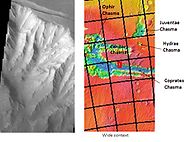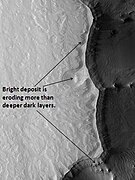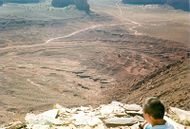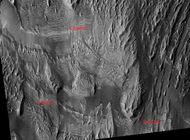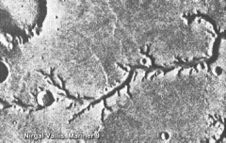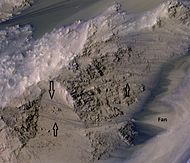Difference between revisions of "Coprates quadrangle"
m (→See Also) |
|||
| Line 141: | Line 141: | ||
*[[Geography of Mars]] | *[[Geography of Mars]] | ||
| − | + | ||
*[[High Resolution Imaging Science Experiment (HiRISE)]] | *[[High Resolution Imaging Science Experiment (HiRISE)]] | ||
*[[HiWish program]] | *[[HiWish program]] | ||
Revision as of 08:33, 3 March 2020
| MC-18 | Coprates | 0–30° S | 45–90° W | Quadrangles | Atlas |
The Coprates Quadrangle contains perhaps the most outstanding feature on Mars—the Valles Marineris chasma system, a set of canyons that would stretch across the United States.

Contents
Location and name
The Coprates quadrangle goes from 0° to 30° south latitude and 45° to 90° west longitude (315-270 E). Coprates quadrangle is famous for depicting the "Grand Canyon of Mars", the Valles Marineris Canyon System. Impressive signs of water exist in this quadrangle, with ancient river valleys and networks of stream channels showing up as inverted terrain and lakes inside of Valles Marineris.[1] The Coprates quadrangle contains parts of many of the old classical regions of Mars: Sinai Planum, Solis Planum, Thaumasia Planum, Lunae Planum, Noachis Terra, and Xanthe Terra. Because Mars has a very thin, clear atmosphere astronomers have been able to see surface markings for hundreds of years. Early observers gave names to them—many from old names from the Bible or old writings. The name Coprates refers to an old name for a river in Persia.[2] The river is the Dez River, a tributary of the Karun in modern Iran. Water from the Dez eventually empties into the Shatt al-Arab near its Persian Gulf estuary. The name was approved by the International Astronomical Union (IAU) in 1958.[3] [4]
Valles Marineris canyon system
Valles Marineris is the largest canyon system in the solar system; this great canyon would go almost all the way across the United States. This section describes the system with words; pictures in this article also show all these features/names.The name for the whole system of canyons is Valles Marineris. Starting at the west with Noctis Labyrinthus in the Phoenicis Lacus quadrangle, the canyon system ends in the Margaritifer Sinus quadrangle with Capri Chasma and Eos Chasma (in the south). The word Chasma has been designated by the International Astronomical Union to refer to an elongate, steep-sided depression. Valles Marineris was discovered by and named for the Mariner 9 mission. Moving east from Noctis Labyrinthus, the canyon splits into two troughs, named Tithonium Chasma and Ius Chasma (in the south). In the middle of the system are the very wide valleys of Ophir Chasma (north), Candor Chasma, and Melas Chasma (south). Going farther to the east, one comes to Coprates Chasma. At the end of Coprates Chasma, the valley gets wider to form Capri Chasma in the north and Eos Chasma in the south. The walls of the canyons often contain many layers. The floors of some of the canyons contain large deposits of layered materials. The layers may have formed when water once filled the canyons.[5] [6][7] [8] The canyons are deep as well as long; in places they are 8-10 kilometers deep, much deeper than the Earth's Grand Canyon, which is only 1.6 kilometers deep.[9]
Melas Chasma, as seen by THEMIS. Click on image to see relationship of Melas Chasma to other features.
Cliff in Candor Chasma Plateau, as seen by THEMIS. Click on image to see relationship with other features in Coprates quadrangle.
Cliff in northern wall of Ganges Chasma, as seen by THEMIS. Click on image to see relationship with other features in the Coprates quadrangle.
Interior layered deposits and sulfate
This quadrangle, as indeed many other quadrangles of Mars, show much evidence of vast amounts of water in the past. Some features like old stream beds clearly point toward a water-rich past for Mars. However, layered features and their chemistry, although not as striking, provide great support for large amounts of water in the past. Parts of the floors of Candor Chasma and Juventae Chasma contain layered deposits that have been given the name interior layered deposits (ILD's) and Equatorial Layered Deposits (ELD's). These layers may have formed when the whole area was a giant lake. However, many other ideas have been advanced to explain them.[10] > High-resolution structural and geologic mapping in west Candor Chasma, presented in March 2015, showed that the deposits on the floor of the Candor Chasma are basin filling sediments that were deposited in a wet playa like setting; hence water was involved in their formation.[11] Some places on Mars contain hydrated sulfate deposits, including ILD's. Sulfate formation involves the presence of water. The European Space Agency's Mars Express found possible evidence of the sulfates epsomite and kieserite. Sulfates that contain water are found in many places on the planet. Usually, they show up in pictures as light-toned materials. These are in striking contrast to the widespread dark volcanic surfaces. Scientists want to visit these areas with robotic rovers.[12] These deposits have been found to contain ferric oxides in the form of crystalline grey hematite.[13] [14] [15] Grey hematite is another sign of water as it usually forms with the aid of water.
Layers
Perhaps, the best location to view layers on Mars is in the Coprates quadrangle. This is probably because of so many huge, deep canyons that display layer after layer in their walls. Images of rocks in the canyon walls almost always show layers.[16] Layered rocks have different characteristics. Some layers appear tougher than others. In the image below of Ganges Chasma Layers, as seen by HiRISE, one can see that the upper, light-toned deposits are eroding much faster than the lower darker layers. Some cliffs on Mars show a few darker layers standing out and often breaking into large pieces; these are thought to be hard volcanic rock instead of soft ash deposits. An example of hard layers is shown below in the picture of layers in the canyon wall in Coprates, as seen by Mars Global Surveyor. Because of its closeness to the Tharsis volcanic region, rock layers may be made of layer after layer of lava flows, probably mixed with deposits of volcanic ash that fell out of the air following big eruptions. Rock strata visible in the walls preserve a long geological history of Mars.[17] The Earth does not possess long records of geological history since plate tectonics erases rock materials at more or less regular intervals. Dark layers in canyon walls may be due to dark lava flows. The dark volcanic rock basalt dominates the Martian surface. However, light-toned deposits appear in many spots, and those deposits may have resulted from rivers, lakes, volcanic ash, or windblown deposits of sand or dust.[18] The Mars Rovers found light-toned rocks to contain sulfates. Probably having been formed in water, sulfate deposits are of great interest to scientists because they may contain traces of ancient life.[19]
Ganges Chasma Layers, as seen by HiRISE].
Layers in the canyon wall in Coprates, as seen by Mars Global Surveyor, under the MOC Public Targeting Program.
Wide view of layers in wall of Valles Marineris, as seen by HiRISE under HiWish program.
Two views of Melas Chasma Layered Deposits, as seen by HiRISE. Left picture lies north of other picture on the right. Pictures are not the same scale. Click on image to see details of layers.
Wide view of layers in Louros Valles, as seen by HiRISE under HiWish program Louros Valles is part of the Ius Chasma.
Hebes Chasma and hydrated deposits
Hebes Chasma, a large enclosed valley, may have once held water. Hydrated minerals have been found there. It is thought that large-scale underground springs of groundwater at different times burst to the surface to form deposits called Light Toned Deposits (LTD's). Some suggest present or fossilized life forms may be found there because the deposits are relatively young.[20]
Nirgal Vallis and sapping
Nirgal Vallis is one of the longest valley networks on Mars. It is so large that it is found on more than one quadrangle. Scientists do not know how all the ancient river valleys were formed. There is evidence that instead of rain or snow, the water that formed the valleys originated underground. One mechanism that has been advanced is groundwater sapping.[21] In the process of sapping, the ground just gives away as water comes out. Sapping is common in some desert areas in America's Southwest. Sapping forms alcoves and stubby tributaries. These features are visible in the picture below of Nigal Vallis taken with Mars Odyssey's THEMIS.
Nirgal Vallis that runs in two quadrangles has features looking like those caused by sapping. Picture taken with THEMIS.
Great flood in Holden Crater
Water from Nirgal Vallis contributed to a great flood that went through the rim of Holden Crater and helped form a lake in the crater. It's estimated that Nirgal Vallis had a discharge of 4800 cubic meters/second.[22] Water from Nirgal Vallis was inbounded in Uzboi Vallis because the rim of Holden Crater blocked the flow. At a certain point the stored water broke through the rim of Holden and created a lake 200–250 m deep.[23] Water with a depth of at least 50 m entered Holden at a rate that 5-10 times the discharge of the Mississippi River.[24] [25] [26] [27] Terraces and the presence of large rocks (tens of meters across) support these high discharge rates.</ref> [28] [29] [30] [31]
Inverted relief
Some areas of Mars show inverted relief, where features that were once depressions, like streams, are now instead above the surface. These may have been formed when materials, like large rocks, were deposited in low-lying areas, and then left behind after erosion (perhaps wind which cannot move large rocks) removed much of the surface layers. Other ways of making inverted relief might be lava flowing down a stream bed or cementation of rock material by minerals dissolved in water. Some cementing materials are very hard and resistant to erosion. On Earth, materials cemented by silica are highly resistant to all kinds of erosional forces. Inverted relief in the shape of streams is further evidence of water flowing on the Martian surface in past times. There are many examples of inverted channels near Juventae Chasma; some are shown in the image of Juventae Chasma below.[32] [33] [34]
Inverted Channels near Juventae Chasma, as seen by HiRISE. Channels were once regular stream channels. Scale bar is 500 meters long.
Vallis
Vallis (plural valles) is the Latin word for valley. It is used in planetary geology for the naming of landform features on other planets. The term “Vallis” was used for old river valleys that were discovered on Mars, when probes were first sent to Mars. The Viking Orbiters caused a revolution in our ideas about water on Mars; huge river valleys were found in many areas. Spacecraft cameras showed that floods of water broke through dams, carved deep valleys, eroded grooves into bedrock, and traveled thousands of kilometers.[35] [36] [37]
Her Desher Vallis, as seen by HiRISE.
Recurrent slope lineae
Recurrent slope lineae (RSL) are small dark streaks on slopes that elongate in warm seasons. They may be evidence of liquid water.[38][39][40]
See Also
References:
- ↑ Cabrol, N. and E. Grin (eds.). 2010. Lakes on Mars. Elsevier. NY
- ↑ Blunck, J. 1982. Mars and its Satellites. Exposition Press. Smithtown, N.Y.
- ↑ "Coprates quadrangle". Gazetteer of Planetary Nomenclature. USGS Astrogeology Research Program.
- ↑ Smith, William, ed. (1854). "Dictionary of Greek and Roman Geography". Perseus Digital Library. Tufts University. Retrieved 6 Dec 2016.
- ↑ Cabrol, N. and E. Grin (eds.). 2010. Lakes on Mars. Elsevier. NY
- ↑ McCauley, J. 1978. Geologic map of the Coprates quadrangle of Mars. U.S. Geol. Misc. Inv. Map I-897
- ↑ {{cite journal | last1 = Nedell | first1 = S. | display-authors = etal | year = 1987 | title = Origin and evolution of the layered deposits in the Valles Marineris, Mars | url = | journal = Icarus | volume = 70 | issue = 3| pages = 409–441 | doi=10.1016/0019-1035(87)90086-8 |
- ↑ Weitz, C. and T. Parker. 2000. New evidence that the Valles Marineris interior deposits formed in standing bodies of water. LPSC XXXI. Abstract 1693
- ↑ Hugh H. Kieffer|title=Mars|url=https://books.google.com/books?id=NoDvAAAAMAAJ%7Caccessdate=7 March 2011|year=1992|publisher=University of Arizona Press|
- ↑ Cabrol, N. and E. Grin (eds.). 2010. Lakes on Mars. Elsevier. NY
- ↑ Okubo, C. 2015. HIGH-RESOLUTION STRUCTURAL AND GEOLOGIC MAPPING IN CANDOR CHASMA. 46th Lunar and Planetary Science Conference. 1210.pdf
- ↑ http://themis.asu.edu/features/candorchasma |title=Bath Salts in Candor Chasma? | Mars Odyssey Mission THEMIS |publisher=Themis.asu.edu |
- ↑ Cabrol, N. and E. Grin (eds.). 2010. Lakes on Mars. Elsevier. NY
- ↑ Christensen | first1 = P. | display-authors = etal | year = 2001 | title = Global mapping of Martian hematite mineral deposits: Remnants of water-driven processes on early Mars | url = | journal = J. Geophys. Res. | volume = 106 | issue = E10| pages = 23873–23885 | doi=10.1029/2000je001415 |
- ↑ Weitz | first1 = C. | display-authors = etal | year = 2008 | title = Gray hematite distribution and formation in Ophir and Candor Chasmata | url = | journal = J. Geophys. Res. | volume = 113 | issue = E2| page = E02016 | doi=10.1029/2007je002930 |
- ↑ Grotzinger, J. and R. Milliken. 2012. Sedimentary Geology of Mars. SEPM.
- ↑ http://themis.asu.edu/features/coprateschasma |title=Landslides and Debris in Coprates Chasma | Mars Odyssey Mission THEMIS |publisher=Themis.asu.edu |date= |
- ↑ http://hirise.lpl.arizona.edu/PSP_005385_1640 |title=HiRISE | Light-toned Layers in Eos Chaos (PSP_005385_1640) |publisher=Hirise.lpl.arizona.edu |date= |
- ↑ http://hirise,lpl.arizona.edu/PSP_007430_1725
- ↑ May Have Played Important Role in Shaping Mars
- ↑ http://themis.asu.edu/zoom-20030916a
- ↑ Irwin | first1 = J. | last2 = Craddock | first2 = R. | last3 = Howard | first3 = R. | year = 2005 | title = Interior channels in Martian valley networks: Discharge and runoff production | url = | journal = Geology | volume = 33 | issue = 6| pages = 489–492 | doi=10.1130/g21333.1|
- ↑ Grant, J., R. Irwin, S. Wilson. 2010. Aqueous depositional settings in Holden crater, Mars In Cabrol, N. and E. Grin (eds.). 2010. Lakes on Mars. Elsevier. NY.
- ↑ Grant | first1 = J. | last2 = Parker | first2 = T. | year = 2002 | title = Drainage evolution of the Margaritifer Sinus region, Mars | url = | journal = J. Geophys. Res. | volume = 107 | issue = E9| pages = 5066 | doi = 10.1029/2001JE001678 |
- ↑ Komar | first1 = P | year = 1979 | title = Comparisons of the hydraulics of water flows in Martian outflow channels with flows of similar scale on Earth | url = | journal = Icarus | volume = 37 | issue = 1| pages = 156–181 | doi=10.1016/0019-1035(79)90123-4 |
- ↑ Grant | first1 = J. |display-authors=et al | year = 2008 | title = HiRISE imaging of impact megabreccia and sub-meter aqueous strata in Holden Crater, Mars | url = | journal = Geology | volume = 36 | issue = 3| pages = 195–198 | doi=10.1130/g24340a.1|
- ↑ Irwin |display-authors=et al | year = 2005 | title = An intense terminal epoch of widespread fluvial activity on early Mars: 2. Increased runoff and paleolake development | url = | journal = J. Geophys. Res. | volume = 110 | issue = E12| pages = E12S15| doi = 10.1029/2005JE002460 |
- ↑ Grant | first1 = J. | last2 = Parker | first2 = T. | year = 2002 | title = Drainage evolution of the Margaritifer Sinus region, Mars | url = | journal = J. Geophys. Res. | volume = 107 | issue = E9| pages = 5066 | doi = 10.1029/2001JE001678 |
- ↑ Boothroyd, J. 1983. Fluvial drainage systems in the Ladon Basin area: Margaritifer Sinus area, Mars. Geol. Soc. Am. Abstr. Programs 15, 530
- ↑ Grant, J. 1987. The geomorphic evolution of Eastern Margaritifer Sinus, Mars. Adv. Planet. Geol. NASA Tech memo. 89871, 1-268.
- ↑ Parker, T. 1985. Geomorphology and geology of the southwestern Margaritifer Sinus-northern Argyre region of Mars, California State University, M. S. Thesis, Los Angeles, California
- ↑ http://hirise.lpl.arizona.edu/PSP_006770_1760 |title=HiRISE | Inverted Channels North of Juventae Chasma (PSP_006770_1760) |publisher=Hirise.lpl.arizona.edu |
- ↑ Malin, M., et al. 2010. An overview of the 1985-2006 Mars Orbiter Camera science investigation. http://marsjournal.org
- ↑ http://www.sciencedirect.com/science/journal/00191035 |title=Icarus | Vol 221, Iss 1, In Progress , (September–October, 2012) |date= |
- ↑ Hugh H. Kieffer (1992). Mars. University of Arizona Press. ISBN 978-0-8165-1257-7.
- ↑ Raeburn, P. 1998. Uncovering the Secrets of the Red Planet Mars. National Geographic Society. Washington D.C.
- ↑ Moore, P. et al. 1990. The Atlas of the Solar System. Mitchell Beazley Publishers NY, NY.
- ↑ McEwen, A., et al. 2014. Recurring slope lineae in equatorial regions of Mars. Nature Geoscience 7, 53-58. doi:10.1038/ngeo2014
- ↑ McEwen, A., et al. 2011. Seasonal Flows on Warm Martian Slopes. Science. 05 Aug 2011. 333, 6043,740-743. DOI: 10.1126/science.1204816
- ↑ http://redplanet.asu.edu/?tag=recurring-slope-lineae



